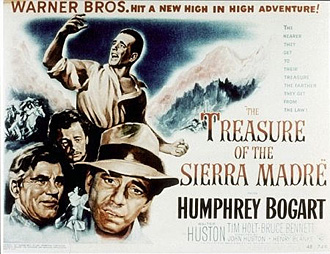Discovering the Treasure of the Sierra Madres
 Jim Scherrer - PVNN Jim Scherrer - PVNN


| | Though the movie tells a story about a couple of down-and-out Americans who join up with a crusty old-timer to prospect for gold in Mexico, the real Treasure of the Sierra Madres is the hills themselves - and the real estate contained therein. |
Do you remember the 1927 novel, "The Treasure of the Sierra Madre," which was about a couple of down-and-out Americans that joined up with a crusty old-timer to prospect for gold in Mexico? It was later adapted into a film by John Huston in 1948, who returned to Puerto Vallarta in 1964 to film "Night of the Iguana."

The Sierra Madres have been and continue to be rich in mineral wealth containing vast deposits of gold, silver, lead, zinc, copper, and tin. The problem is; the majority of us North Americans can't do very much to prosper from or enjoy the benefits associated with these rich mineral assets. However, the Sierra Madres do possess another great asset that we can benefit from and enjoy; that is real estate!

Now, we ask, where exactly are the Sierra Madres? Well, there are actually three mountain ranges in Mexico, all referred to as the Sierra Madres. The first is the Sierra Madre Oriental range that runs about 700 miles from north to the south on the eastern side of Mexico.

On the western side of Mexico, the Sierra Madre Occidental range runs about 700 miles from the US border south to an area just north of Puerto Vallarta. The Sierra Madre del Sur begins close to where the Occidental range ends and continues south to Guatemala.

The two western ranges are bisected by the Trans-Volcanic Axis, which is a geologically active volcanic mountain range whose smoldering cones link the western ranges with the eastern range. This east to west volcanic range starts near Cabo Corrientes, at the southern tip of Puerto Vallarta´s Banderas Bay, and ends just south of Veracruz on the Gulf of Mexico.

Now that we have the geography lesson behind us, let's just position ourselves where three of these four ranges intersect, i.e., in Puerto Vallarta. Standing in Vallarta, we look to the north and see the Sierra Madre Occidental range, to the south we see the Sierra Madre del Sur range, and to the east we see the Trans-Volcanic Axis range.

Yes, even though Puerto Vallarta is located on the Mexican Riviera along the Pacific Ocean coastline, you could say that it's in the center of the Sierra Madres. Being located in the center of the Sierra Madres and on the Pacific Ocean, Vallarta offers some of the most scenic land anywhere on the planet.

Being located at the same latitude as Hawaii, the climate in Vallarta is essentially the same as Hawaii. With the fabulous climate, outrageous views of mountains and ocean, located only two to three hours from the US, and a progressive PAN Party in power, real estate treasures in Vallarta have been discovered!

The coastline from Riviera Nayarit, which covers the area from 45 miles north of Vallarta all the way south to Careyes on the Costa Alegre 55 miles south of Vallarta, is currently undergoing a major transformation. Due to the recent legal changes pertaining to the foreign ownership of coastal land in Mexico, the stable peso, the conservative and pro-US Mexican government, and of course, the onslaught of baby boomers searching for retirement destinations, this entire 100 mile stretch of the Mexican Riviera is exploding with population growth and new development.

One of the results of Mexico's 1917 Revolution was the Agrarian Law, which provided the redistribution of land from the wealthy land owners to the farming peasants. This Agrarian Law prohibited the farmers from ever selling their land; they were only to work it.

However, in 1973, the Mexican government modified the Agrarian Law, thus allowing foreign real estate investment in Mexico. Certain restricted zones were also made available to foreign buyers by establishing the Fideicomiso, or bank trust. This fifty-year bank trust grants the real estate title to a bank, acting as a trustee, who is obligated to follow all instructions given by the trust's beneficiary, the foreign buyer.

The Agrarian Law was again amended in 1993, allowing the Ejido farmers, with unanimous consent, to privatize or regularize their land and sell off parcels to others. In 1994, NAFTA created a dispute-settlement provision to protect direct foreign investments in Mexico. Since the PAN Party took control in 2000, there have been a number of other legal changes, all designed to encourage foreign investments in Mexican real estate. They include financing, title insurance, bank trust regulations, and other tools to provide security to the foreign investor.

All Mexican land within 100 km of the borders and 50 km of the shorelines is considered as restricted zones and treated differently than the interior land. Since the beautiful western coastline property along the Mexican Riviera lies within the 50 km restricted zone, it is being slowly but surely acquired by foreigners through Fideicomisos, as the Ejido farmers privatize it.

Of course, as it converts, its value and selling price skyrockets, thereby providing substantial new wealth for those fortunate land owning families or ejidos. There is so much magnificent coastline available, this process of conversion will probably continue for another generation.

As this coastline gets privatized, sold to foreigners, and developed, the North American baby boomer invasion continues and the local economy thrives as thousands of new construction and service jobs are created.

The head of the local Chamber of Commerce has predicted the population of greater Vallarta to reach 600,000 inhabitants by 2015, making it much larger than many northern US cities such as Cleveland, Ohio. The current construction boom seems relentless as new villas, condominium complexes, shopping centers, and office buildings continue to spring up daily.

While boating in Banderas Bay, you peer across the water and see countless beautiful villas and condominiums nestled in the foothills of the Sierra Madres and you must agree, "There's gold in them thar hills"; the real treasure of the Sierra Madres is the hills themselves and the real estate contained therein. It all lies before your eyes and is now available to you in Puerto Vallarta.

So, why hesitate? Come on down this winter and explore the real estate opportunities that await you in Paradise.
 The founder of Puerto Vallarta Real Estate Buyers' Agents (PVREBA), Jim Scherrer is a retired entrepreneur who has owned property in Puerto Vallarta for 24 years. Utilizing his experience and extensive knowledge of the area, Jim has written a series of informative articles about travel to and retirement in Puerto Vallarta, which you can read on his website at PVREBA.com. The founder of Puerto Vallarta Real Estate Buyers' Agents (PVREBA), Jim Scherrer is a retired entrepreneur who has owned property in Puerto Vallarta for 24 years. Utilizing his experience and extensive knowledge of the area, Jim has written a series of informative articles about travel to and retirement in Puerto Vallarta, which you can read on his website at PVREBA.com.

Click HERE for more articles by Jim Scherrer |



